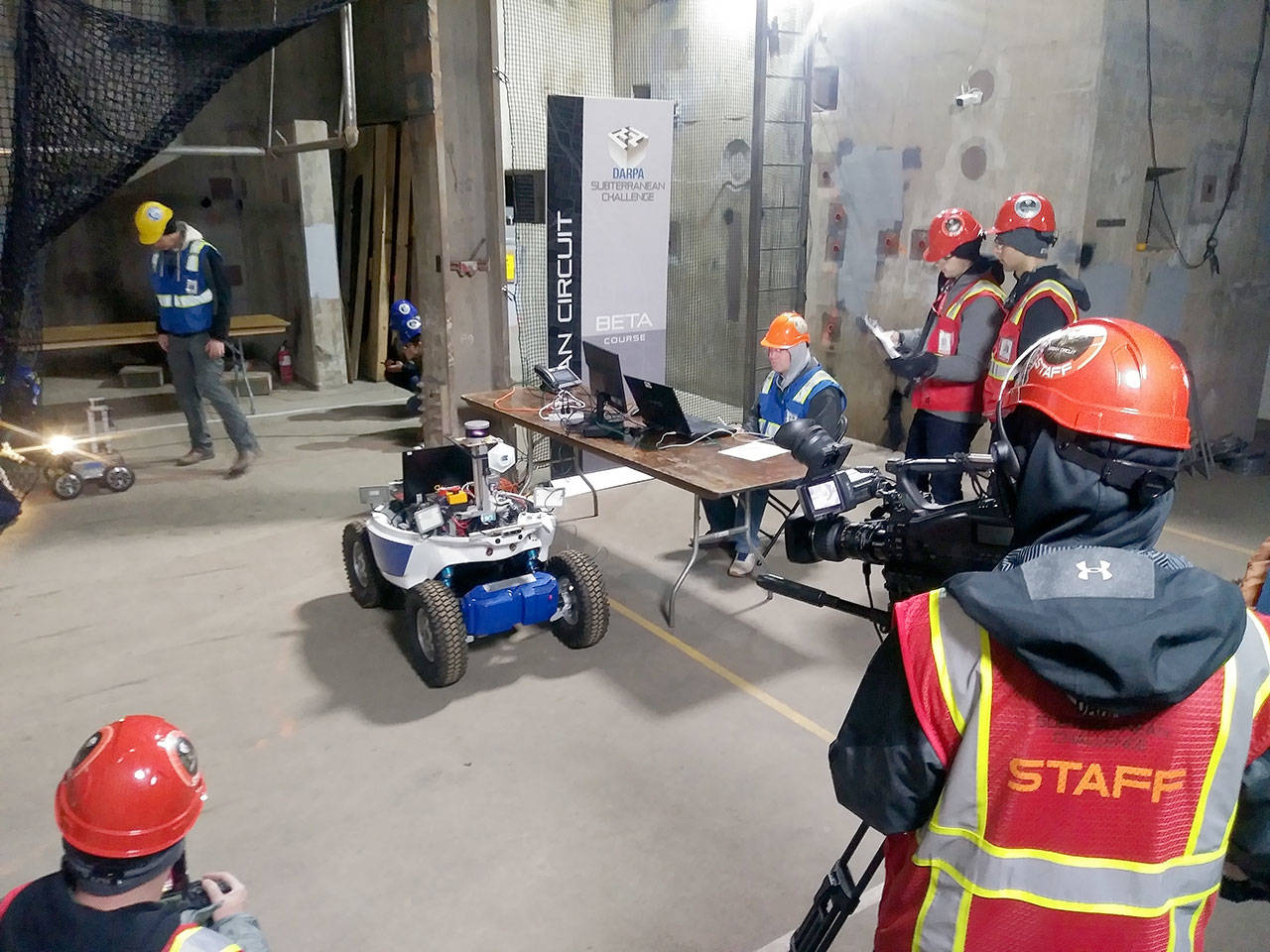The federal Department of Defense has long- and short-term goals it hopes to achieve through contests like the one at Satsop, which concludes this week.
Teams from around the world have gathered in Satsop for the DARPA Subterranean Challenge (SubT), a high-tech competition with prize money at stake and prestige for the teams that best develop abilities for the military to operate below ground.
The Defense Advance Research Projects Agency, which is running the Subterranean Challenge, hopes to create the next generation of scientists and entrepreneurs as well as speeding products to first responders and others who could be kept safe in dangerous situations.
“I think what we’re doing is populating, creating, fostering that additional generation of those that have been tested in field robotics conditions. They have the confidence that comes from having broken a robot or two in these challenging environments,” said Timothy Chung, DARPA’s program manager for the Tactical Technology Office, who is overseeing the competition. Chung has a Ph.D. in mechanical engineering from the California Institute of Technology. “And that confidence might be just what they need to go start a company or create a lab or address real problems that need additional attention.”
That is the long-term goal. He says the short-term goal already is being realized as teams formed of businesses and educational organizations have started developing the products of the future.
“Looking more toward the near term, very near term, we’re seeing a lot of participants coming in with partners from small businesses and companies, so they’re taking lessons from our field settings and turning those into things that will enhance their ability to service their customers,” Chung said. “I’m a firm believer that the types of technologies that we’re seeing at SubT Challenge, whether wholesale or via component technologies, we’re seeing a lot of that spill into the market much more quickly.”
And he believes the technology gained from these competitions will help more than the military and first responders.
“With the notion of being able to provide actionable information, there’s so many applications. That can include everything from real estate and commercial inspection; construction, I think, will play a large role where we can refine how maps are built and the ability to find things on those maps,” Chung said.
On Monday, members of the media got to tour the event and speak with team members.
Ramu Vairavan of the National University of Singapore team, NUS SEDS, said he’s already learned a lot.
“Our take away from this challenge is adjusting to the space. The scale of this competition is much much more than we expected,” he said. Vairavan and his self-funded team had recently completed a run through one of the two courses at the competition. Team NUS SEDS has one point so far from its first two runs out of a possible 40. And the team was excited to get that, considering their shoestring budget. “First of all, robots should be small and portable. You can put a lot of money into it, but you might want to have a throw away robot.”
“Our budget is about $12,000 U.S.,” he said. “Our budget is extremely tight.”
In addition to a tight budget challenge, Vairavan said some of his team’s robots got held up in customs when entering the U.S. And they are just doing this for the opportunity.
“We don’t even get any college credit,” he said.
The DARPA contest runs through today, Feb. 27. Spectators are not allowed at the facility; however, the runs and more can be watched online at youtube.com/user/DARPAtv.
DARPA has a prize pool of millions of dollars for the teams that can best navigate underground courses and find specific artifacts in an attempt to advance the technology used in search and rescue missions.
The teams are mainly partnerships between universities and technology companies, countries represented include Czech Republic, Switzerland, England, South Korea, Sweden, Australia, Canada and Taiwan in addition to the United States. The Coordinated Robotics team is comprised of people from Coordinated Robotics, California State University Channel Islands and Sequoia Middle School in Newbury Park, California.
Universities represented include Cal-Berkeley, Nevada-Reno, Oxford, MIT and Carnegie Mellon.
DARPA, a branch of the federal Department of Defense, held similar contests that led to the self-driving vehicles being commercially tested on roads today.
There are 10 teams competing with an average of about 16 people per team. Many teams are multinational, and 10 countries are represented. There also are more than 80 workers in the area for the competition.
The unfinished nuclear plant at Satsop provides an ideal location for the SubT competition because it offers an underground labyrinth to be explored with multiple levels. That verticality offers the teams an additional challenge to overcome.
The teams have developed robots that fly, move on a tread, move on legs and various combinations there of.
The robots map an underground course and identify what they’ve found.
There are 20 artifacts hidden throughout the subterranean course. Artifacts include heat-emitting mannequins, an air duct vent, tools, phones and atmospheric changes, such as the presence of gases. The robots will have to identify the artifacts without aid from their human operators.



